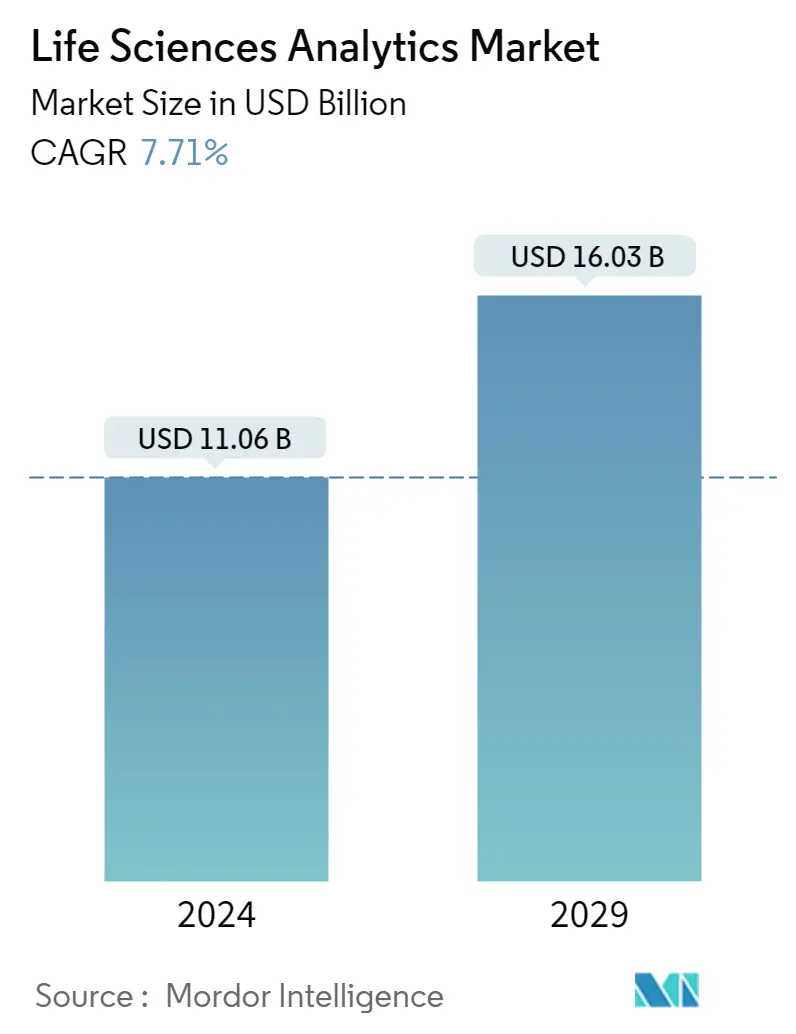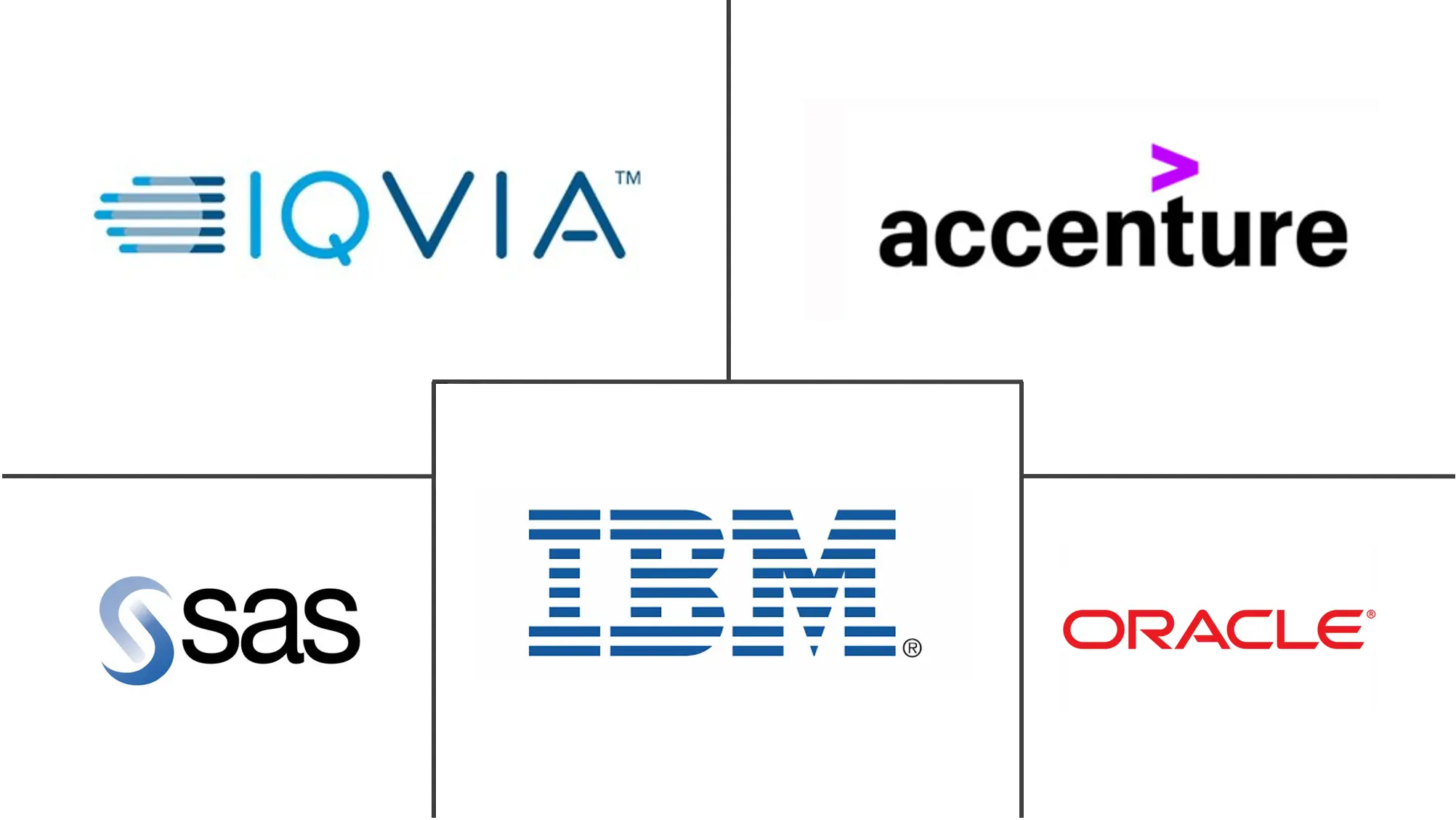Market Size of Life Sciences Analytics Industry

| Study Period | 2021 - 2029 |
| Market Size (2024) | USD 11.06 Billion |
| Market Size (2029) | USD 16.03 Billion |
| CAGR (2024 - 2029) | 7.71 % |
| Fastest Growing Market | Asia Pacific |
| Largest Market | North America |
Major Players
*Disclaimer: Major Players sorted in no particular order |
Life Science Analytics Market Analysis
The Life Sciences Analytics Market size is estimated at USD 11.06 billion in 2024, and is expected to reach USD 16.03 billion by 2029, growing at a CAGR of 7.71% during the forecast period (2024-2029).
The outbreak of COVID-19 contributed to the rise in demand for analytics, as several clinical trials were conducted for the vaccines for COVID-19. In March 2020, the US Department of Veterans Affairs (VA), Department of Energy (DOE), Department of Health and Human Services (HHS), and National Security Council (NSC) formed the COVID-19 Insights Partnership. The COVID-19 Insights Partnership is leveraging big data analytics tools to research and find possible treatments for the virus. For instance, in November 2021, a predictive analytics model was developed based on an artificial neural network (ANN) model to predict the future number of daily cases and deaths caused by COVID-19 in a generalized way. It showed approximately 86% overall accuracy in predicting the mortality rate and 87% in predicting the number of cases. Thus, life sciences analytics models have proven to be effective in the wake of the COVID-19 pandemic, contributing to market growth. Hence, the COVID-19 pandemic has had a significant positive impact on the market studied. Additionally, due to the significance of analytics, the demand for life science analytics is expected to grow considerably in the future.
The significant factors for the growth of the life sciences analytics market include the rising adoption of analytics solutions in pharmaceuticals and clinical trials, growing pressure to reduce healthcare spending, the need for improved patient outcomes, and the emergence of advanced analytics methods in life science companies.
There is a rise in the use of analytics in clinical trials, as conducting clinical trials has become complex because it involves various activities and generates high volumes of data from different systems. With the changing regulatory protocol requirements for clinical trial conduction and the challenges in data collection, analysis, and preparation of a report quickly for submission to the health authority, the adoption of analytics for clinical trials is on the rise. For instance, in June 2021, IQVIA launched a SaaS-based clinical data analytics platform, Clinical Data Analytics Suite (CDAS), for rapid and intelligent clinical trials.
The emergence of advanced analytics in life science companies is also one of the major factors driving market growth. The 2021 ISG Provider Lens Life Sciences Digital Services Report revealed that life sciences companies in the European region are interested in using analytics to support marketing and sales efforts and optimize supply chain operations. Several other companies are also developing analytics solutions, boosting the adoption and use of analytics solutions. For instance, in September 2021, ZS launched ZAIDYN, a platform for life sciences companies of all sizes to digitally transform and scale customer engagement, field performance, analytics, and clinical capabilities. The emergence of such solutions and products encourages life science companies to develop more advanced analytics solutions, thereby boosting market growth.
In June 2021, JADBio entered into a distribution agreement with QIAGEN to sell and distribute the JADBio offering within the QIAGEN Digital Insights portfolio. JADBio is an AutoML platform with leading-edge AI tools and automation capabilities. It is built to enable life-science professionals to build and deploy accurate and interpretable predictive models quickly and timely, regardless of their data science expertise. Thus, the participation of life sciences companies in developing advanced analytics contributes to market growth.
Thus, factors such as new launches by companies, strategic partnerships, and increasing focus on the implementation of analytics in life sciences are expected to boost the market's growth significantly over the forecast period.
However, a lack of skilled personnel and high implementation costs are expected to restrain the market growth during the forecast period.
Life Science Analytics Industry Segmentation
Life sciences analytics refers to any analytical application used in clinical research organizations, pharmaceutical, medical device companies, and various divisions, such as research, supply chain, marketing, pharmacovigilance, and others.
The life sciences analytics market is segmented by product type (descriptive analytics, predictive analytics, and prescriptive analytics), application (research and development, supply chain analytics, sales and marketing, and other applications), component (services and software), end user (clinical research institutions, pharmaceutical and biotechnology companies, medical device companies, and other end users) and geography (North America, Europe, Asia-Pacific, Middle East and Africa, and South America). The market report also covers the estimated market sizes and trends for 17 countries across major regions globally. The report offers the value (USD million) for the above segments.
| By Product Type | |
| Descriptive Analytics | |
| Predictive Analytics | |
| Prescriptive Analytics |
| By Application | |
| Research and Development | |
| Supply Chain Analytics | |
| Sales and Marketing | |
| Other Applications |
| By Component | |
| Services | |
| Software |
| By End User | |
| Clinical Research Institutions | |
| Pharmaceutical and Biotechnology Companies | |
| Medical Device Companies | |
| Other End Users |
| Geography | ||||||||
| ||||||||
| ||||||||
| ||||||||
| ||||||||
|
Life Sciences Analytics Market Size Summary
The life sciences analytics market is poised for significant growth, driven by the increasing adoption of analytics solutions across pharmaceuticals and clinical trials. The demand for these solutions has been bolstered by the complexities of modern clinical trials, which generate vast amounts of data and require sophisticated analytics for efficient management and regulatory compliance. The COVID-19 pandemic further accelerated this trend, as the need for rapid and accurate data analysis became critical in vaccine development and treatment research. The emergence of advanced analytics methods and platforms, such as those developed by companies like IQVIA and ZS, has also contributed to the market's expansion, enabling life science companies to enhance their operational efficiencies and decision-making processes.
North America holds a substantial share of the life sciences analytics market, supported by robust healthcare R&D infrastructure and increased government spending on healthcare. The region's market growth is further fueled by the adoption of analytics to navigate regulatory changes and improve drug development processes. In Canada, government initiatives to strengthen the biomanufacturing and life sciences sector are expected to drive market growth. The competitive landscape is characterized by the presence of key players like Accenture, IBM, and Oracle, who are actively engaging in strategic partnerships and acquisitions to enhance their market offerings. These developments, coupled with the growing importance of analytics in optimizing clinical trials and drug discovery, are set to propel the market forward over the forecast period.
Life Sciences Analytics Market Size - Table of Contents
-
1. MARKET DYNAMICS
-
1.1 Market Overview
-
1.2 Market Drivers
-
1.2.1 Rising Adoption of Analytics Solutions in Pharmaceuticals and Clinical Trials
-
1.2.2 Growing Pressure to Reduce Healthcare Spending and the Need for Improved Patient Outcomes
-
1.2.3 Emergence of Advanced Analytics Method in Life Science Companies
-
-
1.3 Market Restraints
-
1.3.1 Lack of Skilled Personnel
-
1.3.2 High Implementation Costs
-
-
1.4 Porter's Five Forces Analysis
-
1.4.1 Threat of New Entrants
-
1.4.2 Bargaining Power of Buyers/Consumers
-
1.4.3 Bargaining Power of Suppliers
-
1.4.4 Threat of Substitute Products
-
1.4.5 Intensity of Competitive Rivalry
-
-
-
2. MARKET SEGMENTATION (Market Size by Value - in USD million)
-
2.1 By Product Type
-
2.1.1 Descriptive Analytics
-
2.1.2 Predictive Analytics
-
2.1.3 Prescriptive Analytics
-
-
2.2 By Application
-
2.2.1 Research and Development
-
2.2.2 Supply Chain Analytics
-
2.2.3 Sales and Marketing
-
2.2.4 Other Applications
-
-
2.3 By Component
-
2.3.1 Services
-
2.3.2 Software
-
-
2.4 By End User
-
2.4.1 Clinical Research Institutions
-
2.4.2 Pharmaceutical and Biotechnology Companies
-
2.4.3 Medical Device Companies
-
2.4.4 Other End Users
-
-
2.5 Geography
-
2.5.1 North America
-
2.5.1.1 United States
-
2.5.1.2 Canada
-
2.5.1.3 Mexico
-
-
2.5.2 Europe
-
2.5.2.1 Germany
-
2.5.2.2 United Kingdom
-
2.5.2.3 France
-
2.5.2.4 Italy
-
2.5.2.5 Spain
-
2.5.2.6 Rest of Europe
-
-
2.5.3 Asia-Pacific
-
2.5.3.1 China
-
2.5.3.2 Japan
-
2.5.3.3 India
-
2.5.3.4 Australia
-
2.5.3.5 South Korea
-
2.5.3.6 Rest of Asia-Pacific
-
-
2.5.4 Middle East and Africa
-
2.5.4.1 GCC
-
2.5.4.2 South Africa
-
2.5.4.3 Rest of Middle East and Africa
-
-
2.5.5 South America
-
2.5.5.1 Brazil
-
2.5.5.2 Argentina
-
2.5.5.3 Rest of South America
-
-
-
Life Sciences Analytics Market Size FAQs
How big is the Life Sciences Analytics Market?
The Life Sciences Analytics Market size is expected to reach USD 11.06 billion in 2024 and grow at a CAGR of 7.71% to reach USD 16.03 billion by 2029.
What is the current Life Sciences Analytics Market size?
In 2024, the Life Sciences Analytics Market size is expected to reach USD 11.06 billion.

